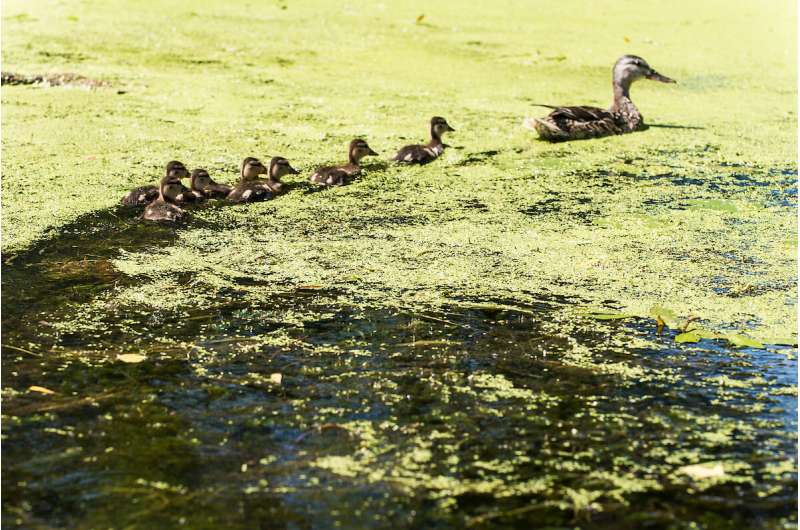Ducks swim through duckweed and algae floating on Lake Mendota during the summer of 2015. Algae blooms are a common sight on many lakes, but new research indicates it’s not a universal trend. Credit: Jeff Miller/WISC
As Earth's average temperature rises, climate change impacts grow around the globe. Hurricanes and wildfires are bigger and more destructive. Extreme rain events are more common. Droughts last longer.
But, surprisingly, one problem isn't getting universally worse. According to a study published today in the journal Frontiers in Ecology and the Environment, there isn't a widespread upswing of harmful algae blooms in North American lakes.
The finding contradicts the common narrative that warmer temperatures and heavier rains are making algae blooms worse in lakes across the landscape, according to Grace Wilkinson, lead author of the study and an assistant professor at the University of Wisconsin–Madison's Center for Limnology.
Wilkinson is quick to clarify that these results shouldn't minimize the impact harmful algal blooms can have.
"For many, many lakes, they are a very serious problem," she says. "But algal blooms are not getting worse everywhere and if we can better understand what's driving one lake getting worse while another one is getting better, that's going to give us a lot more tools in our toolbox to better address this problem."
Wilkinson says that she, too, had assumed that harmful algae blooms were intensifying on a large scale due to climate change. But, when she and her research team began to investigate the science, "we really couldn't find any analysis or citation that supported it," Wilkinson says. "It was just a thing we all said."
But this "thing" has major implications for lakes. Previous research has tied harmful algal blooms to toxic water, human health impacts, fish kills, falling shoreline property values and a slowing waterfront recreation.
To test if perception reflected reality, Wilkinson and her team tracked down data on as many lakes as they could possibly find—and not just any data. To paint the full picture of algal bloom dynamics and trends in a lake, they needed to find datasets where frequent samples were taken over at least a decade. In the end, Wilkinson found useful data on 323 waterbodies thanks to long-term research programs run by state and federal agencies, as well as citizen science monitoring efforts on lakes across the country.
When they dug into these large-scale, long-term trends in harmful algae blooms, it turned out that things weren't as bad as believed. A little more than 10 percent of the lakes showed significant intensification of blooms, while 16 percent actually showed decreasing frequency and severity of blooms. The vast majority of lakes they studied showed no major trend in either direction.
"There are lakes right next door to each other, and in one, harmful algal blooms will be significantly increasing and getting worse and in the other they will be getting better," Wilkinson says. Despite the fact that such lakes often share the same watersheds and the same regional climate patterns, the impacts these factors have on harmful algal blooms "get filtered through the local characteristics of that specific lake," she says.
While her study didn't look specifically at the drivers behind each lake's algal bloom trends, some interesting patterns did emerge. For example, in lakes that were already nutrient rich, increasingly frequent and extreme rain events were strongly correlated with algal bloom trends getting worse. If these same types of lakes were getting fewer extreme precipitation events, then their algal bloom problems were getting better.
Another interesting discovery Wilkinson made in her research was that efforts to meet water quality standards set by the federal Clean Water Act might be paying off. She and her colleagues combed through local news media coverage and found that a substantial number of lakes that showed improving algal bloom trends had been the site of conservation and restoration efforts.
"It turns out local newspapers are a great way to find out what's going on in a community," Wilkinson says.
While the impacts of precipitation and restoration will need further study, they point to the importance of better understanding the mechanisms driving harmful algal bloom trends.
"The key part of this is figuring out why it is getting worse in some places but not somewhere else," Wilkinson says, "because that will help us be better stewards of these water bodies and not just have despair."
More information: Grace M Wilkinson et al, No evidence of widespread algal bloom intensification in hundreds of lakes, Frontiers in Ecology and the Environment (2021). doi.org/10.1002/fee.2421
Journal information: Frontiers in Ecology and the Environment
Provided by University of Wisconsin-Madison
























